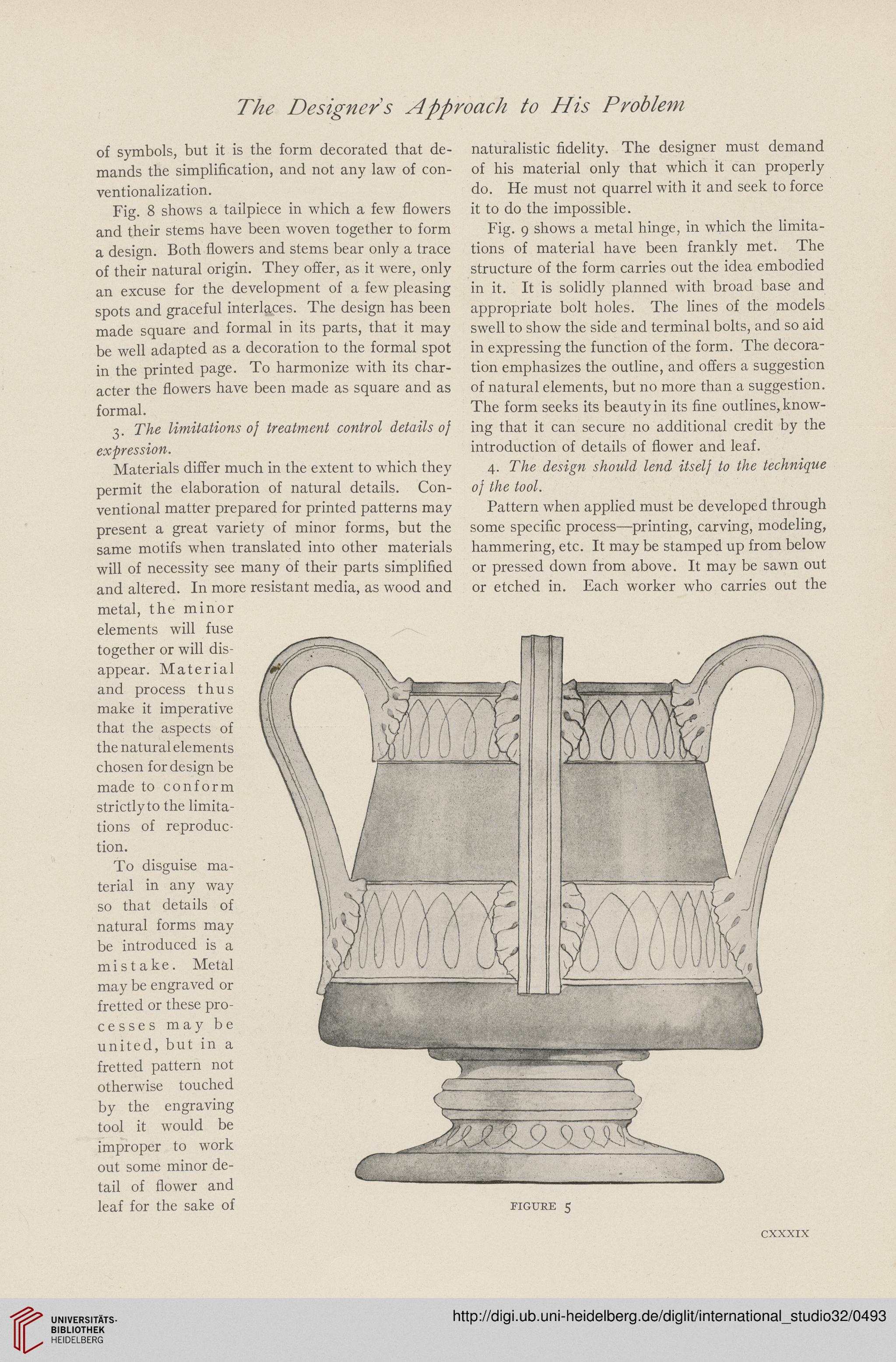The Designer s Approach to His Problem
of symbols, but it is the form decorated that de-
mands the simplification, and not any law of con-
ventionalization.
Fig. 8 shows a tailpiece in which a few flowers
and their stems have been woven together to form
a design. Both flowers and stems bear only a trace
of their natural origin. They offer, as it were, only
an excuse for the development of a few pleasing
spots and graceful interlaces. The design has been
made square and formal in its parts, that it may
be well adapted as a decoration to the formal spot
in the printed page. To harmonize with its char-
acter the flowers have been made as square and as
formal.
3. The limitations 0} treatment control details oj
expression.
Materials differ much in the extent to which they
permit the elaboration of natural details. Con-
ventional matter prepared for printed patterns may
present a great variety of minor forms, but the
same motifs when translated into other materials
will of necessity see many of their parts simplified
and altered. In more resistant media, as wood and
metal, the minor
elements will fuse
together or will dis-
appear. Material
and process thus
make it imperative
that the aspects of
the natural elements
chosen for design be
made to conform
strictly to the limita-
tions of reproduc-
tion.
To disguise ma-
terial in any way
so that details of
natural forms may
be introduced is a
mistake. Metal
may be engraved or
fretted or these pro-
cesses may be
united, but in a
fretted pattern not
otherwise touched
by the engraving
tool it would be
improper to work
out some minor de-
tail of flower and
leaf for the sake of
naturalistic fidelity. The designer must demand
of his material only that which it can properly
do. He must not quarrel with it and seek to force
it to do the impossible.
Fig. 9 shows a metal hinge, in which the limita-
tions of material have been frankly met. The
structure of the form carries out the idea embodied
in it. It is solidly planned with broad base and
appropriate bolt holes. The lines of the models
swell to show the side and terminal bolts, and so aid
in expressing the function of the form. The decora-
tion emphasizes the outline, and offers a suggestion
of natural elements, but no more than a suggestion.
The form seeks its beauty in its fine outlines, know-
ing that it can secure no additional credit by the
introduction of details of flower and leaf.
4. The design should lend itself to the technique
of the tool.
Pattern when applied must be developed through
some specific process—printing, carving, modeling,
hammering, etc. It may be stamped up from below
or pressed down from above. It may be sawn out
or etched in. Each worker who carries out the
PADUAN
—
FIGURE 5
CXXXIX
of symbols, but it is the form decorated that de-
mands the simplification, and not any law of con-
ventionalization.
Fig. 8 shows a tailpiece in which a few flowers
and their stems have been woven together to form
a design. Both flowers and stems bear only a trace
of their natural origin. They offer, as it were, only
an excuse for the development of a few pleasing
spots and graceful interlaces. The design has been
made square and formal in its parts, that it may
be well adapted as a decoration to the formal spot
in the printed page. To harmonize with its char-
acter the flowers have been made as square and as
formal.
3. The limitations 0} treatment control details oj
expression.
Materials differ much in the extent to which they
permit the elaboration of natural details. Con-
ventional matter prepared for printed patterns may
present a great variety of minor forms, but the
same motifs when translated into other materials
will of necessity see many of their parts simplified
and altered. In more resistant media, as wood and
metal, the minor
elements will fuse
together or will dis-
appear. Material
and process thus
make it imperative
that the aspects of
the natural elements
chosen for design be
made to conform
strictly to the limita-
tions of reproduc-
tion.
To disguise ma-
terial in any way
so that details of
natural forms may
be introduced is a
mistake. Metal
may be engraved or
fretted or these pro-
cesses may be
united, but in a
fretted pattern not
otherwise touched
by the engraving
tool it would be
improper to work
out some minor de-
tail of flower and
leaf for the sake of
naturalistic fidelity. The designer must demand
of his material only that which it can properly
do. He must not quarrel with it and seek to force
it to do the impossible.
Fig. 9 shows a metal hinge, in which the limita-
tions of material have been frankly met. The
structure of the form carries out the idea embodied
in it. It is solidly planned with broad base and
appropriate bolt holes. The lines of the models
swell to show the side and terminal bolts, and so aid
in expressing the function of the form. The decora-
tion emphasizes the outline, and offers a suggestion
of natural elements, but no more than a suggestion.
The form seeks its beauty in its fine outlines, know-
ing that it can secure no additional credit by the
introduction of details of flower and leaf.
4. The design should lend itself to the technique
of the tool.
Pattern when applied must be developed through
some specific process—printing, carving, modeling,
hammering, etc. It may be stamped up from below
or pressed down from above. It may be sawn out
or etched in. Each worker who carries out the
PADUAN
—
FIGURE 5
CXXXIX




